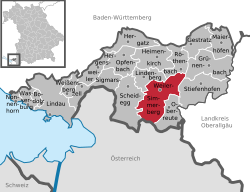Weiler im Allgäu
| Weiler-Simmerberg | ||
|---|---|---|

Weiler-Simmerberg Town Hall
|
||
|
||
| Coordinates: 47°35′N 9°56′E / 47.583°N 9.933°ECoordinates: 47°35′N 9°56′E / 47.583°N 9.933°E | ||
| Country | Germany | |
| State | Bavaria | |
| Admin. region | Schwaben | |
| District | Lindau | |
| Government | ||
| • Mayor | Karl-Heinz Rudolph | |
| Area | ||
| • Total | 31.30 km2 (12.08 sq mi) | |
| Elevation | 630-900 m (−2,320 ft) | |
| Population (2016-12-31) | ||
| • Total | 6,205 | |
| • Density | 200/km2 (510/sq mi) | |
| Time zone | CET/CEST (UTC+1/+2) | |
| Postal codes | 88171 | |
| Dialling codes | 08387 (Weiler-Simmerberg) 08384 (Ellhofen) | |
| Vehicle registration | LI | |
Weiler-Simmerberg is a market town in the Swabian Lindau district.
Being located in the Westallgäu, the market town is bordering on the region of the Bregenz Forest, which already belongs to the Austrian administrative region of Vorarlberg. The Hausbachklamm belongs to the prominent landmarks and sights of Weiler-Simmerberg, as well as the Enschenstein and the Wildrosenmoos. Even though the landscape is rather mild, there are many very cliffy and steep rock faces due to the irregular bedding of sandstone and conglomerate.
The area of Weiler-Simmerberg consists of the "Gemarkungen" Ellhofen, Simmerberg and Weiler im Allgäu.
The following districts belong to the market town of Weiler-Simmerberg:
The municipality celebrated the 1.111th anniversary of its first mentioning in 2005. The market town of Weiler-Simmerberg had been seat of a higher and lower court before 1805 and belonged to the Austrian authority of Bregenz-Hohenegg. Since the signing of the peace treaties of Brünn und Preßburg in 1805, the town belongs to Bavaria. In the course of the administrative reforms in Bavaria, the contemporary municipality was formed by the "Gemeindeedikt" of 1818.
Weiler-Simmerberg is twinned with:
...
Wikipedia



